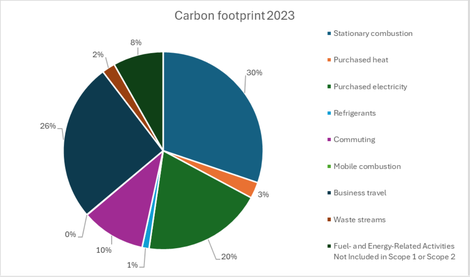CO2eq footprint Ghent University
Ghent University has been calculating its carbon footprint every year since 2019. This is the sum of all the greenhouse gases we emit. With our climate plan, we aim to reduce our university's total emissions year on year. The end goal? The Paris Climate Agreement standard: net zero emissions by 2050.
Scope
The carbon footprint includes both direct and indirect emissions of various greenhouse gases, such as CO2, divided into 3 'scopes':
- Scope 1: the direct emissions of greenhouse gases on our campuses through the consumption of fuels, gas, own cars and the release of refrigerant gases
- Scope 2: indirect greenhouse gas emissions from the consumption of purchased electricity and heat produced elsewhere
- Scope 3: all other indirect emissions, mainly due to:
- Mobility, i.e. staff commuting and business trips
- Waste processing
- Indirect emissions from the activities below are not yet taken into account due to the high uncertainty and incompleteness of the available data:
What's yet not included:
- Commuter traffic and air travel by students
- Production of purchased materials, such as equipment, ICT hardware, materials, chemicals, consumables, food for the student restaurants, etc.
- Construction and renovation of buildings and paved surfaces
Allocation of CO2 emissions and evolution
Our CO2 footprint amounts to 39.987 tonnes CO2e (analysis year 2023). The vast majority of this can be attributed to energy consumption, air travel and commuting.
Allocation of CO2 footprint 2023

Evolution of CO2 footprint from 2019 to 2023
Goal
We calculated science-based targets . Science-based targets are a scientific framework to initiate the transition to a low-carbon organisation. It is a methodology to set reduction targets in line with what the latest climate studies show to keep global warming to ‘well below 2°C’ (WB2C) or ‘1.5°C’ (1.5C).
For Ghent University, the Science Based Targets by 2030 (relative to base year 2019) amount to:
- WB2C: from 52k tCO2e in 2019 to 38k tCO2e in 2030 (minus 27.5% or minus 15k tCO2e)
- WB1.5C: from 52k tCO2e in 2019 to 28k tCO2e in 2030 (minus 46.2% or minus 26k tCO2e)
UGent endorsed the EU ambition to be climate neutral by 2050, thus aligning itself at least with the WB2C, but aiming for the WB1.5C. This ambition was translated into targets, both in terms of energy (direct emissions) and emissions from purchases and travel (indirect emissions).
It was initially chosen to realise proportionate efforts in the different sectors to pursue this overall target. At a later stage, the target could be tightened in certain sectors, in order to go slightly less far or slower in another sector.
Strategy
The trajectory for the next 10 years was made concrete with a Climate Plan. For all relevant policy plans, ambitions are set, boundaries defined and actions formulated in transition plans. The results are monitored annually by the Executive Board and actions are adjusted where necessary.
